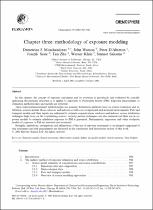JavaScript is disabled for your browser. Some features of this site may not work without it.
- ResearchSpace
- →
- Research Publications/Outputs
- →
- Journal Articles
- →
- View Item
| dc.contributor.author |
Moschandreas, DJ

|
en_US |
| dc.contributor.author |
Watson, J

|
en_US |
| dc.contributor.author |
D'Abreton, P

|
en_US |
| dc.contributor.author |
Scire, J

|
en_US |
| dc.contributor.author |
Zhu, T

|
en_US |
| dc.contributor.author |
Klein, W

|
en_US |
| dc.contributor.author |
Saksena, S

|
en_US |
| dc.date.accessioned | 2007-02-06T12:57:59Z | en_US |
| dc.date.accessioned | 2007-06-07T10:04:45Z | |
| dc.date.available | 2007-02-06T12:57:59Z | en_US |
| dc.date.available | 2007-06-07T10:04:45Z | |
| dc.date.copyright | en_US | |
| dc.date.issued | 2002-12 | en_US |
| dc.identifier.citation | Moschandreas, DJ, et al. 2002. Chapter three: methodology of exposure modeling. Chemosphere, vol. 49(9), pp 923-946 | en_US |
| dc.identifier.issn | 0045-6535 | en_US |
| dc.identifier.uri | http://hdl.handle.net/10204/1538 | en_US |
| dc.identifier.uri | http://hdl.handle.net/10204/1538 | |
| dc.description.abstract | In this chapter, the concept of exposure assessment and its evolution is introduced, and evaluated by critically appraising the pertinent literature as it applies to exposures to Particulate Matter (PM). Exposure measurement or estimation methodologies and models are reviewed. Three exposure/measurement methodologies are assessed. Estimation methods focus on source evaluation and attribution, sources include those outdoors and indoors as well as in occupational and in-transit environments. Fate and transport models and their inputs are addressed to estimate concentrations outdoors and indoors; source attribution techniques help focus on the contributing sources. Activity pattern techniques are also reviewed and their use in exposure models to estimate inhalation exposure to PM is presented. Deterministic, regression and other stochastic models of exposure to PM are reviewed and evaluated. Strengths, limitations, assumptions and affirmations of the use of exposure assessment as an integral component of risk assessment and risk management are discussed in the conclusions and discussions section of this work. | en_US |
| dc.format.extent | 300443 bytes | en_US |
| dc.format.mimetype | application/pdf | en_US |
| dc.language.iso | en | en_US |
| dc.publisher | Pergamon-Elsevier Science Ltd | en_US |
| dc.rights | Copyright: 2002 Pergamon-Elsevier Science Ltd | en_US |
| dc.source | en_US | |
| dc.subject | Exposure assessment | en_US |
| dc.subject | Exposure models | en_US |
| dc.subject | Source attribution techniques | en_US |
| dc.subject | Source modeling approaches | en_US |
| dc.subject | Receptor model estimates | en_US |
| dc.subject | Human activity patterns | en_US |
| dc.subject | Particulate matter | en_US |
| dc.subject | Environmental sciences | en_US |
| dc.title | Chapter three: methodology of exposure modeling | en_US |
| dc.type | Article | en_US |
| dc.identifier.apacitation | Moschandreas, D., Watson, J., D'Abreton, P., Scire, J., Zhu, T., Klein, W., & Saksena, S. (2002). Chapter three: methodology of exposure modeling. http://hdl.handle.net/10204/1538 | en_ZA |
| dc.identifier.chicagocitation | Moschandreas, DJ, J Watson, P D'Abreton, J Scire, T Zhu, W Klein, and S Saksena "Chapter three: methodology of exposure modeling." (2002) http://hdl.handle.net/10204/1538 | en_ZA |
| dc.identifier.vancouvercitation | Moschandreas D, Watson J, D'Abreton P, Scire J, Zhu T, Klein W, et al. Chapter three: methodology of exposure modeling. 2002; http://hdl.handle.net/10204/1538. | en_ZA |
| dc.identifier.ris | TY - Article AU - Moschandreas, DJ AU - Watson, J AU - D'Abreton, P AU - Scire, J AU - Zhu, T AU - Klein, W AU - Saksena, S AB - In this chapter, the concept of exposure assessment and its evolution is introduced, and evaluated by critically appraising the pertinent literature as it applies to exposures to Particulate Matter (PM). Exposure measurement or estimation methodologies and models are reviewed. Three exposure/measurement methodologies are assessed. Estimation methods focus on source evaluation and attribution, sources include those outdoors and indoors as well as in occupational and in-transit environments. Fate and transport models and their inputs are addressed to estimate concentrations outdoors and indoors; source attribution techniques help focus on the contributing sources. Activity pattern techniques are also reviewed and their use in exposure models to estimate inhalation exposure to PM is presented. Deterministic, regression and other stochastic models of exposure to PM are reviewed and evaluated. Strengths, limitations, assumptions and affirmations of the use of exposure assessment as an integral component of risk assessment and risk management are discussed in the conclusions and discussions section of this work. DA - 2002-12 DB - ResearchSpace DP - CSIR KW - Exposure assessment KW - Exposure models KW - Source attribution techniques KW - Source modeling approaches KW - Receptor model estimates KW - Human activity patterns KW - Particulate matter KW - Environmental sciences LK - https://researchspace.csir.co.za PY - 2002 SM - 0045-6535 T1 - Chapter three: methodology of exposure modeling TI - Chapter three: methodology of exposure modeling UR - http://hdl.handle.net/10204/1538 ER - | en_ZA |






